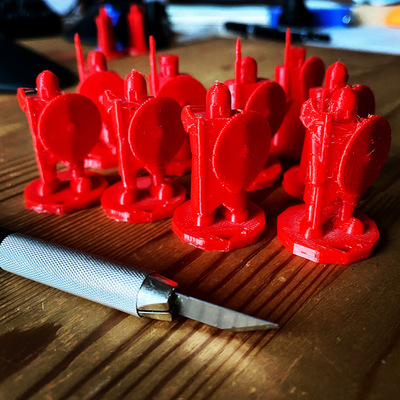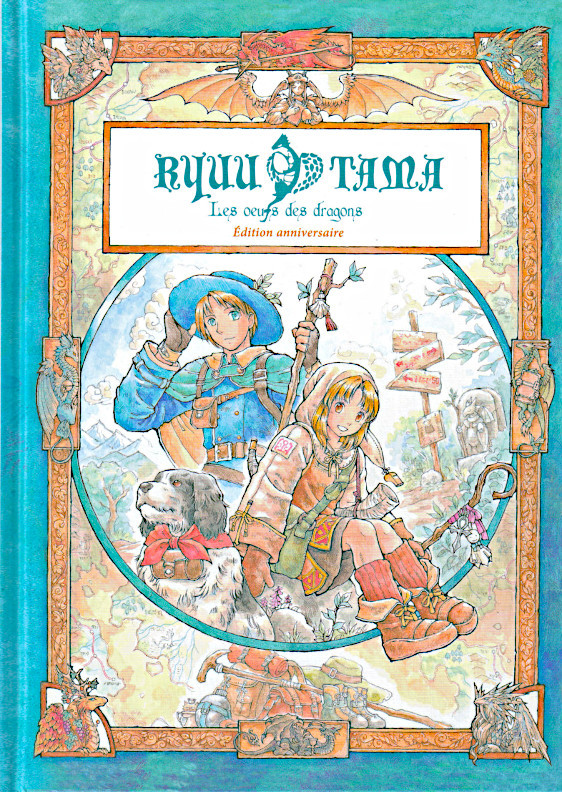
|
Ryuu Ex Machina |
| 2021-03-23 |
Ryuu Ex Machina

I came up with the title "Ryuu Ex Machina" while reading the "Referee Guide". I read "follow the rules" and "use the dragon-person to smooth out your errors" and thought "Ryuu Ex Machina".
In French we have this saying "Traduire, c'est trahir", it rhymes nicely and says something similar to "Translation is Treachery", which, well, doesn't rhyme.
It'd be lots of work to me to determine if this translation to French of Ryuutama is treachery or not. Contemplating the end result tells me that it is not. If it's not treachery to the original, could it be something less severe, like misunderstanding? I think not.
The edition I own is an anniversary edition. The first french edition was published in 2013, this new edition followed in 2019 and is enhanced with a reworked text, and with the integration of 10 years of running the game experience by the author, Okada Atsuhiro.
The french edition also sports 4 extra annexes: a referee guide, a scenario named Deadly Eve, a campaign backbone named indecent proposal, and conception notes. Abundance.
No treachery here, kudos to the editor Lapin Marteau for providing us so many good things! (They have a page of Ryuutama PDFs with 7 extra scenarios, and the player guide).
Here is a quote from the conception notes (treachery mine):
In reality, I am so fond of being a game master that I made it my job. Since 2002, I run Daydream, a "Table Talk Café" where board games and TTRPG lovers in Tōkyō gather. I manage the café and serve drinks, and I master games two to three times a week. I should have become tired of it, but the pleasure never left. Somehow, I doubt I'll have enough of a life to try all I'd like my players to experience.
I ordered the rulebook and the scenario booklet "Contes d'Orient et d'Occident" together. I was more interested in the booklet, but was nevertheless impressed by the rulebook itself when they arrived.
Why the interest in the scenario booklet? Well, it contains five scenarios from four french TTRPG authors and one from Okada Atsuhiro. The authors are all very experienced, I am attracted to their effort to play by the rules of Ryuutama and provide us with excellent pieces that may teach us a lot.
Anthony "Yno" Combrexelle (bio) wrote "The Happiness-Gates of the Sun" a quest scenario (levels 2 to 4). A painter, Pablo, has gone missing and his family would like the party to find him and bring him home.
John Grümph (bio), helped by Lapin Marteau's Jérôme "Brand" Larré (bio) gives us "Dragon Heart", a hunt scenario (levels 6 to 7), a gritty and morally challenging piece taking place during a war.
Jérôme Larré and Vincent Ziec (bio) came up with "Au vent mauvais" (bad wind), a quest scenario (levels 6 to 8), where the players might meet a retired traveller who'll teach them about the role of the dragon-persons.
Laurent Devernay (bio) wrote "Yétigre Peak", a quest scenario (levels 4 to 6), and a Christmas tale.
And finally Okada Atsuhiro gave a legendary travel "The Thorn Dragonmen" for characters of level 10.
The four "french" scenarios follow the Ryuutama format: introduction - structure - events - stat blocks. That's part of the fun, looking at the authors and seeing how they manage to compose within the lines.
The original author's scenario, since it's a legendary travel, breaks the format a bit (and we might as well grant him the freedom he deserves).
The only thing I find a bit disappointing is that the scenario booklet reuses the illustrations of the rulebook. I wish they could have newer illustrations from Nagamori Ayako. In the conception notes, I was happy to read how Okada Atsuhiro convinced her and about the pang of emotion he felt upon receiving the first images from her.
(There seems to be a spanish scenario booklet with illustrations I have not yet seen, I have to take a look at it).
The rulebook has five pages on how to create a scenario. It's not something vague like in many other games, it's really a way to structure the thing, hence the "format" I mention in the lines above.
The "format" might seem stiff, "railroadish", here is an explanation from the referee guide chapter:
In a country (Japan) where inviting people to one's home is very rare, a lot of TTRP gamers play in places rented by the hour, like, for example, karaoke boxes. Time must be efficiently used, time-consuming selfish drives have to be limited, so much shorter and structured sessions are favoured. Thus the introduction scenarios in this book may seem short and stiff.
Here is a final quote, this time from the referee guide chapter:
To tell that a referee must scrupulously follow the rules is not very popular in the West. "Rulings not rules" has become a mantra. Every referee has to admit that they were at least once in a pinch because a player knew the rules a bit better thant they did, or because the rules seemed to dictate something which felt illogical.
Ryuutama expects you, like your fellow japanese gamers, to follow the rules. Nobody forces you to do it, and like in most games, not following them won't prevent you from having fun. However, you'll miss certain interesting aspects of the game. For instance, you could miss the essence of the dragon-person. Their breaths, their awakenings, and some of their artefacts are the tools with which the referee bends the rules.
In my quest to become a better referee and creator, this french edition and its scenario booklet may well be important finds. I'd like to play the game with my children, but my daughter wants to be a dragon-person...
Kudos again to Lapin Marteau for the excellent edition with extra value and the wonderful scenario booklet.
